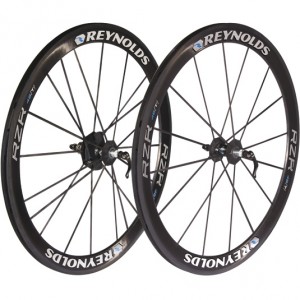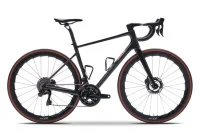Reynolds RZR Initial Review
 We have had a set of Reynolds’ top-of-the-line wheels, the Reynolds RZR, in the shop all season for demo, many of you have seen and admired them. After wrestling them away from Ian, I had the fortunate opportunity to ride these wheels for a weekend recently. Ian has ridden these wheels on his bike all season and he can give a more detailed analysis. However, here are my impressions of these wheels.
We have had a set of Reynolds’ top-of-the-line wheels, the Reynolds RZR, in the shop all season for demo, many of you have seen and admired them. After wrestling them away from Ian, I had the fortunate opportunity to ride these wheels for a weekend recently. Ian has ridden these wheels on his bike all season and he can give a more detailed analysis. However, here are my impressions of these wheels.
Let’s get this out of the way first – I want these wheels! But I am getting ahead of myself. First some, general information about these wheels. The Reynolds RZR offers a tubular rim, hub and spokes that are constructed of a blend of carbon fiber and boron fiber. The carbon spokes are of an N.A.C.A. symmetrical airfoil shape, not simply flat bladed spokes. The rim section is 46.5 mm deep, and 21.25 mm wide; the rim profile is nicely aerodynamic, incorporating Reynolds’ patented “Swirl Lip Generator”, a small raised edge which helps air flow reattach to the rim as it travels over the trailing edge, thus reducing turbulence. The rear hub has 3 flanges, so that one set of rear spokes transfers power directly from the rim to the hub, rather than laterally from the outside to the rim, creating a stronger connection between hub and rim. Bearings are ceramic. The skewers are titanium. The Reynolds RZR wheelset weighs 968 grams. Yes, you read that right. 968 grams is not the rear wheel weight, but rather the weight of the entire wheelset! These wheels rival the Lightweight Obermayers as the lightest aerodynamic wheels on the market.
I have ridden other wheels in the same category as the RZR as part of test rides of client bikes, Lightweights for one. But this has primarily been on shorter rides, this was the first time I really got to ride a pair of such wheels for an extended time. I had some, baseless, preconceived notions about what to expect from the Reynolds RZR. I figured that these wheels would be fast in a straight line. Given that these wheels are so light, I expected that they would be either very stiff and a bit harsh, or much too wimpy and soft. I expected them to be twitchy or a bit unstable, particularly on descents. My first notion was correct – the Reynolds RZR is fast. Very fast. This became apparent immediately upon exiting my driveway, standing up to accelerate up to speed. My thoughts went something like this, “Who’s pushing me?”, “Ah, nobody.”, “Very cool.” With so little rotating weight, the bike simply shot forward, accelerating very quickly. On a climb, the lightweight of the Reynolds RZR makes a very noticeable difference, allowing me to hold a higher gear for a longer time. In that I climb like a stone, this was much appreciated. This performance confirmed that light wheels are more important to climbing than a light frame.
Given the aerodynamic shape of the rim and spokes, and minimal effort needed to keep them rotating, I expected the wheels to be fast in a straight line and they were. These observations may seem obvious. How could an aerodynamic, extremely light, aerodynamically shaped wheelset not accelerate quickly, be fast in a straight line, and climb like the wind? However, what is not so obvious are the other handling characteristics of these wheels. My first foray down a hill was tentative. My confidence in these wheels increased with each descent, until I was descending with the same verve as my Mavic Ksyriums. Contrary to my expectations, the Reynolds RZR were a rock solid and stable wheel, which was particularly noticeable when descending. The Reynolds RZR are also a quick-handling wheel, responding to my inputs without hesitation. Some of this has to do with the fact that the RZR is quite laterally stiff. I am not particularly light, pushing the limits of the recommended maximum rider weight for these wheels, but even with that I could not detect any flex under stress, such as when climbing out of the saddle. By the way, their recommended weight limit is 180 pounds. This lateral stiffness did not translate into a harsh ride, however. They rode very smoothly – at least on par with wheels like the Mavic R-Sys in terms of vibration damping. In summary, the Reynolds RZR does everything very, very well. And that is an understatement – these are arguably the best wheels available for a bicycle today.
Needless to say, these are not budget wheels. As the old saying goes, you get what you pay for. Greatness is not inexpensive, although cost does not automatically mean something is great. Are these wheels worth the $6,000 price of admission? Is a Porsche 911 worth that much more than a Miata? They are both sports cars, right? Are Wilson MAXX 3 stereo speakers worth that much more than a pair of Pioneer bookshelf speakers? They both play music. Is organic produce worth paying a premium over mass farm? Only you as a prospective buyer can make that personal cost/benefit analysis. I can state, without reservation, that there are substantial (pick-your-own-superlative adjective) benefits to these wheels. Benefits that are unavailable from all but a very, very select few wheels on the market today. It all depends on your perspective and passion – but rest assured that these wheels can change the way you think about riding and the way your bike performs. So, anyway, as I was saying, I WANT THEM and I do think they are worth eating Raman noodles for a year in order to get!









